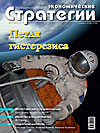Hysteresis Loop
Opening address of editor-in-chief.

Opening address of editor-in-chief.
The present scientific article, based on applying geo-civilizational reproductive-cyclical macro-model, proposes a System of Goals (Goals tree) for sustainable development of the Eurasian civilization and the main strategy directions to achieve them. On the basis of the World Bank statistics an analysis by five factors (coordinated with the structure of civilizations genotype) is carried out: socio-demographic, agrifood, energyecological, scientific-technological and economic.
The article investigates the global shifts in the world economy and changes in commodity markets, where Russia has a wide range of economic interests and international projects, and is also facing a number of challenges. These are fall in demand and lower prices for basic energy, the growing contradictions and rivalry between the major players, the political pressure and the introduction of market constraints (sanctions). The author raises the question of a new paradigm of development, combining pre-empting the future and reacting in the moment, proactive and reactive strategies based on objective analysis and the deserving moral guidelines.
The article considers the techniques for choosing priorities of economic development from points of view of various economic theory schools. The authors are keen to show the importance of defining priorities for realization of strategic planning idea on the basis of international experience and tools of economic policy. The authors are inclined to believe that the top priority of economic policy should be the population welfare growth, which can be achieved in different ways using different tools.
The article provides an analysis of the possible stabilization of world GDP in the forecast period, including explanation by the systemic long-term falling of oil prices. Given that the world GDP is the value of all goods and services of final consumption, the GDP decline can be attributed to their cheapening. This price reduction can be caused by high rates of innovation and technological development of the world economy. The article presents argumentation that the decline in the world GDP has a longterm nature. Even recessionary development of the global economy is possible. But it is not disastrous. The world economy under the influence of innovation processes is reconstructed through information technology replenishment and through reducing production costs of goods and services for final consumption. The article shows at the model level that countries with a low GDP per capita may have even greater potential for transition to an information economy than countries with a high GDP per capita. This opens a window of opportunities for Russia to modernize the economy in accordance with the evolving trends of the global innovation process.
The article dwells on the possibilities and prospects of Azerbaijan in the current difficult political and economic situation in the world and the country. Removing sanctions from Iran, tension in Russian-Turkish relations, oil prices decline, escalation of Karabakh conflict — how these and other factors will affect the economy of one of the most developed countries of the Transcaucasus.
The article discusses the diversification option for the military-industrial complex enterprises through forming and implementing the state strategic order of civil products.
The article describes technical and economic issues of providing defense potential in the aerospace sector under in conditions of increasing military and technological challenges and threats and implementing the strategy of import substitution. The paper presents analysis of the information-technological problems of development of domestic military-industrial complex enterprises — developers of aerospace defense systems, it identifies reserves for increasing their efficiency through introducing integrated information systems. On the example of “VNIIRT” JSC the paper presents prospects for implementing the lean manufacturing concept on the basis of product lifecycle management technology. It gives comparative characteristics of cooperation business models in the defense industry both in foreign countries and in Russia. The article identifies technological and organizational-economic factors of developing cooperation of the final integrators, sub-integrators and components suppliers in the military products manufacturing. It sets out system-forming elements of a risk-oriented approach to forming co-operation in the defense-industrial complex. The authors propose a mathematical model of risk indicator for the company-finalist when choosing the composition of enterprises participating in cooperation, based on aggregation of private indicators of scientific and technical, industrial and technological, financial and economic risks. They formulate long-term objectives for the proposed approach implementation with application of neural network technology.
With this publication we start a series of articles observing Russia’s development in transition to a digital society. The article deals with the challenges facing the country.
The development of network society (the network revolution) in the present-day world necessitates the establishment of networked regulatory organizations that can exert a positive influence on this process. They represent analogs of biomolecular chaperons that function in the living cell. Such social chaperons can design optimal scenarios of the network revolution. They can take account of various possible organizational options (paradigms) of network structures. Chaperons can creatively use paradigms that function in biological systems ranging from unicellular organisms to schooling fish, social insects, and apes. Social chaperons can contribute to their implementation using the whole spectrum of possible strategies of promoting expedient network scenarios and convincing political leaders and government regulators of their importance for humankind.